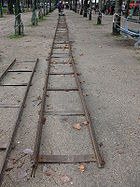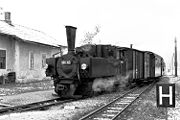
Heeresfeldbahn
Encyclopedia

Feldbahn
A Feldbahn is the German term for a narrow gauge railway, usually not open to the public, which in its simplest form provides for the transportation of agricultural, forestry and industrial raw materials such as wood, peat, stone, earth and sand...
en) designed for the military transportation purposes.
History

Front line
A front line is the farthest-most forward position of an armed force's personnel and equipment - generally in respect of maritime or land forces. Forward Line of Own Troops , or Forward Edge of Battle Area are technical terms used by all branches of the armed services...
s the military developed its own system of field railways (Feldbahn
Feldbahn
A Feldbahn is the German term for a narrow gauge railway, usually not open to the public, which in its simplest form provides for the transportation of agricultural, forestry and industrial raw materials such as wood, peat, stone, earth and sand...
en), usually built to a narrow gauge
Narrow gauge
A narrow gauge railway is a railway that has a track gauge narrower than the of standard gauge railways. Most existing narrow gauge railways have gauges of between and .- Overview :...
. In addition to the general advantages of narrow gauge railways - they took up less space and could have tighter curves, for example - narrow gauge vehicles and track was more easily transportable and could be quickly moved to conform as the location of the front line changed.
Unlike road transportation, the establishment of a Heeresfeldbahn required the construction of expensive and time-consuming railway infrastructure (albeit of simpler design than conventional railways). They were built by specialist troops trained by the military, known as Eisenbahnpioniere. As a war progressed prisoners of war were also employed. The Heeresfeldbahn is tied to this fixed infrastructure; under artillery bombardment or other acts of war it is not flexible enough compared with lorry transport. A Heeresfeldbahn can also be quickly captured and used by an army's opponents. This could become a major disadvantage if the army has to retreat and is unable to lift or destroy the railway quickly enough.
Due to these disadvantages, the Heeresfeldbahn completely lost its importance in the second half of the 20th century and was replaced by road vehicles which were now more technically advanced, cross-country capable and did not require specially trained crews. In particularly difficult terrain, air transportation is now also used (especially helicopters). The use of military railways is now largely restricted to internal transportation functions on large military sites, e.g. for transportation at munitions depots. In addition there are Feldbahn
Feldbahn
A Feldbahn is the German term for a narrow gauge railway, usually not open to the public, which in its simplest form provides for the transportation of agricultural, forestry and industrial raw materials such as wood, peat, stone, earth and sand...
en on some military training areas e.g. large targets may be mounted on tipper trucks that are hauled by motorised locomotives as mobile targets for live firing exercises.
Subsequent civilian use

Bosanski Brod
Brod also known as Bosanski Brod is a town and municipality located on the south bank of the river Sava in the northern part of Bosnia and Herzegovina. It is situated in the north-western part of the Republika Srpska and the western part of the Posavina region.-Name:Prior to the Bosnian War it...
to Zenica
Zenica
Zenica is an industrial city in Bosnia and Herzegovina. It is the capital of the Zenica-Doboj Canton of the Federation of Bosnia and Herzegovina entity...
in Bosnia was quickly expanded into a fully operational narrow gauge railway for general use, thus founding the extensive railway network built to the so-called Bosnian gauge of 760 mm. Even after the First World War, when the Heeresfeldbahnen were used very widely, a number of routes were used for public transport. For example, the Grödnerbahn in Tyrol
County of Tyrol
The County of Tyrol, Princely County from 1504, was a State of the Holy Roman Empire, from 1814 a province of the Austrian Empire and from 1867 a Cisleithanian crown land of Austria-Hungary...
was built as a supply line to the Dolomite front. The narrow gauge line from Skopje
Skopje
Skopje is the capital and largest city of the Republic of Macedonia with about a third of the total population. It is the country's political, cultural, economic, and academic centre...
to Ohrid
Ohrid
Ohrid is a city on the eastern shore of Lake Ohrid in the Republic of Macedonia. It has about 42,000 inhabitants, making it the seventh largest city in the country. The city is the seat of Ohrid Municipality. Ohrid is notable for having once had 365 churches, one for each day of the year and has...
in Macedonia, over 200 km long with a gauge of 600 mm, was originally a military railway of this type.
Transportable Feldbahn track materiel, locomotives and wagons were often sold to civilian companies after the cessation of hostilities and the politically-driven disbandment of the troops responsible for them. This materiel was occasionally still in use for decades after the war's end. For example, in some peat works today there are still track sections from the Imperial Austrian Military Railway to be found and in Feldbahn museums there is a variety of steel relicts to be seen.
Rolling stock

Heeresfeldbahnlokomotive
A Heeresfeldbahnlokomotive is the German term for a special wartime locomotive for employment on military field railways , railways usually designed to transport military supplies to the front line.- Classes :...
n (lit: army field railway locomotives) were characterised by their simple, rugged design, their ability to negotiate very tight curve radii and travel over extremely poor-quality trackbeds safely. These design features also made them interesting for civilian uses such as the forest railways (Waldbahnen) used in forestry or on civilian field railways (Feldbahnen).
Kasemattenbahn
A special type of Heeresfeldbahn is the Kasemattenbahn (lit: casemate railway), specifically for use in fortified military installations. It is usually used to ensure a reliable and copious provision of supplies inside the narrow passages of casemates. They are found, for example, on the Atlantic WallAtlantic Wall
The Atlantic Wall was an extensive system of coastal fortifications built by Nazi Germany between 1942 and 1944 along the western coast of Europe as a defense against an anticipated Allied invasion of the mainland continent from Great Britain.-History:On March 23, 1942 Führer Directive Number 40...
, the fortified installations in the Ardennes
Ardennes
The Ardennes is a region of extensive forests, rolling hills and ridges formed within the Givetian Ardennes mountain range, primarily in Belgium and Luxembourg, but stretching into France , and geologically into the Eifel...
and in fortified British harbours.
See also
- FeldbahnFeldbahnA Feldbahn is the German term for a narrow gauge railway, usually not open to the public, which in its simplest form provides for the transportation of agricultural, forestry and industrial raw materials such as wood, peat, stone, earth and sand...
- Forest railwayForest railwayA forest railway, logging railway or logging railroad is a mode of railway transport which is used for forestry tasks, primarily the transportation of felled logs to sawmills or railway stations.- History :...
- Light railwayLight railwayLight railway refers to a railway built at lower costs and to lower standards than typical "heavy rail". This usually means the railway uses lighter weight track, and is more steeply graded and tightly curved to avoid civil engineering costs...
- Military railwaysMilitary railwaysMilitary railways are a form of transport communication technology used by the military forces for movement of strategically significant forces, bulk cargo or as a platform for military systems....
- Trench railwaysTrench railwaysTrench Railways represented military adaptation of early 20th century railway technology to the problem of keeping soldiers supplied during the static trench warfare phase of World War I...
Sources
- Alfred B. Gottwaldt, Heeresfeldbahnen, Transpress, Stuttgart, ISBN 3-613-70818-3, 1st edition, 1998
- Wernekke, Victor von Röll, Feldbahnen für militärische Zwecke, Urban & Schwarzenberg, Berlin, Wien, Enzyklopädie des Eisenbahnwesens, Vol 5, 1914, pp 54–58
- Rüdiger Fach, Günter Krall, Heeresfeldbahnen der Kaiserzeit, Kenning, Nordhorn, ISBN 3-933613-46-9, 1st Edition, 2002
- Dieter Stanfel, K.u.k. Militärfeldbahnen im Ersten Weltkrieg, DGEG, Hövelhof, ISBN 978-3-937189-41-3, 2008
External links
- Heersfeldbahn website
- Heeresfeldbahnwagen website
- There is a relevant English-language forum at Railways of Germany

